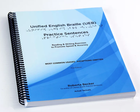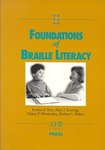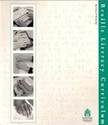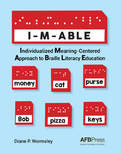- Home
-
Learn
- History of VI >
- Legislation & Laws >
- Vision Professionals >
-
VI Program Resources
>
- Program Printables
- Itinerant Teaching Tips
- Year at a Glance
- VI Program Handbook
- Caseload Analysis
- Organization & Time Management
- Professional Development
- Teacher Standards
- Professional Ethics
- Awards & Recognition
- APH Scholar Program
- Professional Organizations
- Certification Organizations
- Dealing with Challenges
- Professional Publications >
- Relatable Books for All Ages >
- Family Resources >
- Plan
- Basics
-
Teach
- Teaching Strategies >
-
Compensatory Skills Instruction
>
-
Social Skills
>
-
Self Determination
>
- Body Image & Acceptance
- Making Personal Goals
- My Vision Presentation
- My Self-Description
- Create a Personal Data Sheet
- Disclosure Decision
- Disability Statement
- Requesting Help
- Fighting Fears
- My Circle of Support
- Personal Responsibility
- Advocate for Safe Enviroments
- Having Picture Taken
- Coping with Change
- Aging Eyes
- Physical Characteristics
- Political Activism
- Laws Regarding Persons with Disabilities
-
Sensory Efficiency
>
-
Independent Living
>
- Orientation & Mobility Instruction >
- Recreation & Leisure >
-
Career & Vocation
>
-
Grow
- Complete Set Bonus >
-
Recorded Presentations
>
- Webinar: Tips for Being a "Physically Fit" TVI
- Webinar: The Art of Teaching the ECC
- Webinar: Virtual & F2F Strategies
- Webinar: Foundations of Teaching the ECC in the Age of Virtual Instruction
- Webinar: Itinerant Teaching Strategies
- Webinar: Using Themes to Teach the ECC
- Webinar: Conducting a FVLMA
- Webinar: Selecting the Right AT
- Webinar: Developing SMARTER Goals
- Webinar: Determining Service Intensity Using the VISSIT
- Webinar: Activities to Teach the ECC
- Webinar: Accessible Content for BLVI
- Webinar: Accommodations for VI
- Webinar: MIMO Strategies & Activities
- Webinar: SIDPID Strategies & Activities
- Webinar: Standard Course of Study Strategies & Activities
- Webinar: Job Tasks for Job, Career & Life
- Shop
- Jobs
Braille Resource BooksThe following are resource books and online resources specific to working with students who are blind or visually impaired. If there are additional resource books or websites you feel should be listed here, please let me know by completing the form below and I will add them.
Affiliate Link DisclaimerTeaching Students with Visual Impairments is a participant in the Amazon Services LLC Associates Program, an affiliate advertising program designed to provide a means for sites to earn advertising fees by advertising and linking to amazon. As an affiliate, I earn from qualifying purchases. While I appreciate your support, please compare prices from other retailers that sell these products. Thank you in advance for your support! 
Ashcroft's Programmed Instruction in Braille, Fourth Edition (APIB), formerly titled, New Programmed Instruction in Braille Instruction. Although I used an older edition before the introduction of the UEB braille code, this is the program I used when learning braille. It is programmed with current English Braille American Edition rules integrated, cross-referenced and summarized throughout. Fourth Edition revisions include the latest BANA rule changes. The Fourth Edition continues the use of ink-printed braille for easier reading. Chapters and exercises are meaningful, human-interest material along with answer keys for immediate feedback and self-correction. Newly validated tests and answer keys facilitate learning independently or with a class and instructor.

Becker, Roberta. Unified English Braille Practice Sentences. This book of practice sentences, available from ActualTactuals, was created by the co-author of Literary Braille Practice Sentences (with Phil Mangold). It is available in both print and braille and includes all UEB contractions. Sentences progress from simple to complex, making it easy to select appropriate exercises for individual students. The print book includes simulated braille on facing pages. The contractions are introduced one at a time where possible with sufficient repetition for mastery. The book progresses through all of the various types of braille contractions.
Cleveland, Jeri. Braille FUNdamentals. Texas School for the Blind and Visually Impaired (TSBVI). This resource book is a program for teaching the braille code. The program can be used with beginning braille readers as well as those who need additional practice in reading and writing. Activity suggestions are designed for a variety of age levels. This book includes a pre-braille assessment, braille checklists, and ideas for games.

D'Andrea, Frances Mary. Instructional Strategies for Braille Literacy. American Foundation for the Blind (AFB), 1997. It provides specific strategies and methodologies for teaching braille. It provides strategies for working with students with additional disabilities as well. It also contains information on assessment and technology and includes assessment forms.

Koenig, Wormsley, Baker, Rex. Foundations of Braille Literacy. American Foundation for the Blind (AFB), 1994. This resource book addresses the teaching of braille reading and writing in the context of literacy in general, the whole language approach, and how print reading and writing are taught. A combination of theory and practice. Areas covered include perspectives on literacy; history of literacy for people who are blind; learning process of people who are blind; changing views on teaching reading and writing; braille reading literacy; and braille writing literacy. The book also covers assessment of braille literacy skills.

Olson, Myrna R. Guidelines and Games for Teaching Efficient Braille Reading. American Foundation for the Blind (AFB), 1981. This resource book provides unique guidelines and games that can be used in adapting a general reading program to the needs of braille readers and enriching early instruction in braille.

Swenson, Anna M. Beginning with Braille: A Balanced Approach to Literacy American Foundation for the Blind (AFB), 1999. This resource book provides activities and creative and practical strategies for promoting literacy at the early stages of braille instruction. It also includes tips on designing worksheets, introducing braille contractions, teaching the use of the braillewriter, and facilitating the writing process in braille. The book also addresses guidelines for designing individualized instruction, the literacy of students with additional disabilities, and assessment of student progress in developing braille literacy skills.

Wright and Stratton. On the Way to Literacy Handbook, 2nd edition. American Printing House for the Blind. 2007. This revised version, available from APH with quota funds, includes comprehensive information about emergent literacy. It brings together material from a variety of sources to give teachers and parents information about how literacy develops for a young child with a visual impairment, from birth until the child begins to read and write. It discusses areas of development that form a foundation for literacy and everyday activities that support a child’s learning in these areas.

Wormsley, Diane P. Braille Literacy Curriculum. Towers Pr Overbrook School for the Blind, 2000. Presents strategies for incorporating braille into the total curriculum.This book includes ideas and practical tips and techniques for teaching braille. Suggestions included are appropriate for those with and without additional physical or cognitive disabilities. Areas covered include creating braille-rich environments, selecting and teaching key words, teaching tactile perception skills, encouraging writing skills, creating stories, and keeping records.

Wormsley, Diane. I-M-Able: Individualized Meaning Centered Approach to Braille Literacy Education. American Foundation for the Blind, 2016. I-M-ABLE, or the Individualized Meaning-Centered Approach to Braille Literacy Education, is an innovative, individualized, student-centered method for teaching braille and making it exciting for children who have difficulties learning braille. In this teaching approach, instruction is centered on continuously analyzing the strengths and needs of students, placing particular emphasis on engaging them using key vocabulary words and phrases based on their experiences and interests.
The Instruction Manual for Braille Transcribing - Fifth Edition, 2009 is designed for use by students in the correspondence course in English braille transcribing conducted by the Library of Congress, National Library Service for the Blind and Physically Handicapped (NLS), and for use by instructors of braille classes. The course is intended to familiarize the student with the braille system, with braille contractions and their usage, and with the rules of braille transcribing. Rules are set forth by the Braille Authority of North America (BANA) and published in English Braille American Edition (EBAE).
|
History of Visual Impairments
Professional Practice
Vision Professionals
Professionalism
Teacher Resources
Professional Publications
VI Book Resources
|
|
Teaching Students with Visual Impairments LLC
All Rights Reserved |
- Home
-
Learn
- History of VI >
- Legislation & Laws >
- Vision Professionals >
-
VI Program Resources
>
- Program Printables
- Itinerant Teaching Tips
- Year at a Glance
- VI Program Handbook
- Caseload Analysis
- Organization & Time Management
- Professional Development
- Teacher Standards
- Professional Ethics
- Awards & Recognition
- APH Scholar Program
- Professional Organizations
- Certification Organizations
- Dealing with Challenges
- Professional Publications >
- Relatable Books for All Ages >
- Family Resources >
- Plan
- Basics
-
Teach
- Teaching Strategies >
-
Compensatory Skills Instruction
>
-
Social Skills
>
-
Self Determination
>
- Body Image & Acceptance
- Making Personal Goals
- My Vision Presentation
- My Self-Description
- Create a Personal Data Sheet
- Disclosure Decision
- Disability Statement
- Requesting Help
- Fighting Fears
- My Circle of Support
- Personal Responsibility
- Advocate for Safe Enviroments
- Having Picture Taken
- Coping with Change
- Aging Eyes
- Physical Characteristics
- Political Activism
- Laws Regarding Persons with Disabilities
-
Sensory Efficiency
>
-
Independent Living
>
- Orientation & Mobility Instruction >
- Recreation & Leisure >
-
Career & Vocation
>
-
Grow
- Complete Set Bonus >
-
Recorded Presentations
>
- Webinar: Tips for Being a "Physically Fit" TVI
- Webinar: The Art of Teaching the ECC
- Webinar: Virtual & F2F Strategies
- Webinar: Foundations of Teaching the ECC in the Age of Virtual Instruction
- Webinar: Itinerant Teaching Strategies
- Webinar: Using Themes to Teach the ECC
- Webinar: Conducting a FVLMA
- Webinar: Selecting the Right AT
- Webinar: Developing SMARTER Goals
- Webinar: Determining Service Intensity Using the VISSIT
- Webinar: Activities to Teach the ECC
- Webinar: Accessible Content for BLVI
- Webinar: Accommodations for VI
- Webinar: MIMO Strategies & Activities
- Webinar: SIDPID Strategies & Activities
- Webinar: Standard Course of Study Strategies & Activities
- Webinar: Job Tasks for Job, Career & Life
- Shop
- Jobs

